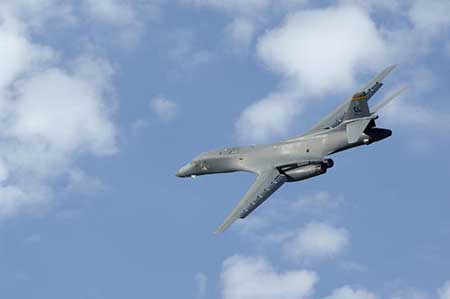USAF B-1B bombers and Navy and Marine Corps F-18 fighters unleashed 34,500 pounds of bombs, striking 40 targets during a round of precision strikes that targeted an al Qaeda “defensive belt” around Arab Jabour, Iraq, according to Army Col. Terry Ferrell, commander of 3rd Infantry Division’s 2nd Brigade Combat Team. The Jan. 20 airstrikes targeted improvised explosive devices and weapons caches. The strikes continued the work begun Jan. 10, as part of Operation Phantom Phoenix. Despite the seeming massive bombardment, Ferrell said the Army worked in a “very detailed, deliberate process” where soldiers sat beside airmen to “identify the targets, … describe what effects we want to achieve, and then they [airmen] work back through the Air Force system to get the desired effects.” (His statement echoes that of Lt. Gen. Gary North, head of US Central Command Air Forces, who explained that modern airstrikes are not carpet-bombing endeavors.) Ferrell noted that the roadside bombs and other explosives “pose great risk to our soldiers, catastrophic risk to our soldiers, and we’ve used the Air Force to help reduce those risks.” Air Force Col. Peter Donnelly, commander of the 18th Expeditionary Air Support Operations Group, said that the nighttime operation reduced the potential for collateral damage. In his view, “the enemy is back on their heels and the Army is chasing them north and south.” USAF F-16s also participated in the operation, striking house-borne IEDs. (AFPS report by Tim Kilbride; CAOC report by TSgt. Tara O’Brien)
B-1B bombers and Navy and Marine Corps F-18 fighters unleashed 34,500 pounds of bombs, striking 40 targets during a round of precision strikes that targeted an al Qaeda “defensive belt” around Arab Jabour, Iraq, according to Army Col. Terry Ferrell, commander of 3rd Infantry Division’s 2nd Brigade Combat Team. The Jan. 20 airstrikes targeted improvised explosive devices and weapons caches. The strikes continued the work begun Jan. 10, as part of Operation Phantom Phoenix. Despite the seeming massive bombardment, Ferrell said the Army worked in a “very detailed, deliberate process” where soldiers sat beside airmen to “identify the targets, … describe what effects we want to achieve, and then they [airmen] work back through the Air Force system to get the desired effects.” (His statement echoes that of Lt. Gen. Gary North, head of US Central Command Air Forces, who explained that modern airstrikes are not carpet-bombing endeavors.) Ferrell noted that the roadside bombs and other explosives “pose great risk to our soldiers, catastrophic risk to our soldiers, and we’ve used the Air Force to help reduce those risks.” Air Force Col. Peter Donnelly, commander of the 18th Expeditionary Air Support Operations Group, said that the nighttime operation reduced the potential for collateral damage. In his view, “the enemy is back on their heels and the Army is chasing them north and south.” USAF F-16s also participated in the operation, striking house-borne IEDs. (AFPS report by Tim Kilbride; CAOC report by TSgt. Tara O’Brien)
Air Force Gen. Alexus G. Grynkewich assumed command of U.S. European Command on July 1, taking over the key assignment as the U.S. and its allies contend with a resurgent Russia and a grinding war in Ukraine.
